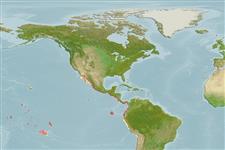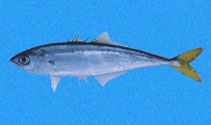Oligoplites refulgens Gilbert & Starks, 1904
Shortjaw leatherjacket
Add your observation in Fish Watcher
| Native range | All suitable habitat | Point map | Year 2050 |

|
| This map was computer-generated and has not yet been reviewed. |
| Oligoplites refulgens AquaMaps Data sources: GBIF OBIS |
Upload your photos and videos
Pictures | Google imageOligoplites refulgens
Picture by Robertson, R.
Pictures | Google imageOligoplites refulgens
Picture by Robertson, R.
Mexico country information
Common names:
Piña flaca, Sardina piña, Zapatero chaqueta de cuero
Occurrence: native
Salinity: brackish
Abundance: | Ref:
Importance: | Ref:
Aquaculture: | Ref:
Regulations: | Ref:
Uses: no uses
Comments: Also Ref. 4537.
National Checklist:
Country Information: https://www.cia.gov/library/publications/resources/the-world-factbook/geos/mx.html
National Fisheries Authority:
Occurrences: Occurrences Point map
Main Ref: Anonymous, 1994
National Database:
Occurrence: native
Salinity: brackish
Abundance: | Ref:
Importance: | Ref:
Aquaculture: | Ref:
Regulations: | Ref:
Uses: no uses
Comments: Also Ref. 4537.
National Checklist:
Country Information: https://www.cia.gov/library/publications/resources/the-world-factbook/geos/mx.html
National Fisheries Authority:
Occurrences: Occurrences Point map
Main Ref: Anonymous, 1994
National Database:
Common names from other countries
Classification / Names Nombres comunes | Sinónimos | Catalog of Fishes(Género, Especie) | ITIS | CoL | WoRMS | Cloffa
> Carangiformes (Jacks) > Carangidae (Jacks and pompanos) > Scomberoidinae
Etymology: Oligoplites: Greek, oligos = small + Greek, hoplites = armed (Ref. 45335).
More on authors: Gilbert & Starks.
Etymology: Oligoplites: Greek, oligos = small + Greek, hoplites = armed (Ref. 45335).
More on authors: Gilbert & Starks.
Environment: milieu / climate zone / depth range / distribution range Ecología
marino; salobre. Tropical; 35°N - 20°S
Distribución Países | Áreas FAO | Ecosistemas | Ocurrencias, apariciones | Point map | Introducciones | Faunafri
Eastern Pacific: Mexico to Ecuador. Also reported from Paita, Peru (Ref. 5530).
Tamaño / Peso / Age
Maturity: Lm ? range ? - ? cm
Max length : 28.2 cm TL macho / no sexado; (Ref. 124487); common length : 20.0 cm FL macho / no sexado; (Ref. 9283); peso máximo publicado: 145.24 g (Ref. 124487)
Max length : 28.2 cm TL macho / no sexado; (Ref. 124487); common length : 20.0 cm FL macho / no sexado; (Ref. 9283); peso máximo publicado: 145.24 g (Ref. 124487)
Short description Claves de identificación | Morfología | Morfometría
Body strongly compressed and elongate (depth from 4.5 to 5.4 times in standard length); posterior end of upper jaw reaching middle of eye; upper jaw teeth small and villiform; lower branch of first gill arch with 19 to 22 gill rakers; scales small but visible, needle-shaped, embedded in the skin; back dark gray; belly and flanks silvery or blue gray with yellow highlights; dorsal and anal fins charcoal colored; pelvic fins white; pectoral and caudal fins yellow (Ref. 55763).
Adults are found in littoral waters (Ref. 9283). They tolerate low salinities and may temporarily penetrate estuarine waters (Ref. 9283). The dorsal and anal spines are connected to venomous glands that can cause painful wounds (Ref. 9283). Marketed fresh and salted or dried (Ref. 9283).
Life cycle and mating behavior Madurez | Reproducción | Puesta | Huevos | Fecundidad | Larva
Main reference
Upload your references | Referencias | Coordinador : Smith-Vaniz, William F. | Colaboradores
Smith-Vaniz, W.F., 1995. Carangidae. Jureles, pámpanos, cojinúas, zapateros, cocineros, casabes, macarelas, chicharros, jorobados, medregales, pez pilota. p. 940-986. In W. Fischer, F. Krupp, W. Schneider, C. Sommer, K.E. Carpenter and V. Niem (eds.) Guia FAO para Identification de Especies para lo Fines de la Pesca. Pacifico Centro-Oriental. 3 Vols. FAO, Rome. (Ref. 9283)
IUCN Red List Status (Ref. 130435: Version 2024-1)
Least Concern (LC) ; Date assessed: 30 April 2008
Human uses
Pesquerías: escaso valor comercial
FAO(pesquerías: producción; publication : search) | FishSource | Sea Around Us
Más información
Trophic ecology
componentes alimenticios
Composición de la dieta
consumo de alimento
Food rations
Despredadores
componentes alimenticios
Composición de la dieta
consumo de alimento
Food rations
Despredadores
Population dynamics
Coeficiente del crecimiento para
Max. ages / sizes
Length-weight rel.
Length-length rel.
Length-frequencies
Mass conversion
Reclutamiento
Abundancia
Coeficiente del crecimiento para
Max. ages / sizes
Length-weight rel.
Length-length rel.
Length-frequencies
Mass conversion
Reclutamiento
Abundancia
Life cycle
Reproducción
Madurez
Fecundidad
Puesta
Spawning aggregations
Huevos
Egg development
Larva
Dinámica larvaria
Reproducción
Madurez
Fecundidad
Puesta
Spawning aggregations
Huevos
Egg development
Larva
Dinámica larvaria
Anatomy
Superficie branquial
Brain
Otolith
Superficie branquial
Brain
Otolith
Physiology
Body composition
Nutrients
Consumo del oxígeno
Tipo de natación
Velocidad de natación
Visual pigments
Fish sound
Diseases & Parasites
Toxicity (LC50s)
Body composition
Nutrients
Consumo del oxígeno
Tipo de natación
Velocidad de natación
Visual pigments
Fish sound
Diseases & Parasites
Toxicity (LC50s)
Genetics
Genética
Heterozygosity
heritabilidad
Genética
Heterozygosity
heritabilidad
Human related
Aquaculture systems
Perfiles de acuicultura
Razas
Ciguatera cases
Stamps, coins, misc.
Aquaculture systems
Perfiles de acuicultura
Razas
Ciguatera cases
Stamps, coins, misc.
Herramientas
E-book | Guía de campo | Asistente para frecuencias de tallas | Herramienta de ciclo de vida | Mapa de puntos | Classification Tree
| Catch-MSY |
Special reports
Download XML
Fuentes de Internet
Aquatic Commons | BHL | Cloffa | Websites from users | Check FishWatcher | CISTI | Catalog of Fishes(Género, Especie) | DiscoverLife | ECOTOX | Faunafri | Fishtrace | GenBank(genome, nucleotide) | GloBI | GOBASE | | Google Books | Google Scholar | Google | IGFA World Record | MitoFish | Otolith Atlas of Taiwan Fishes | PubMed | Reef Life Survey | Scirus | SeaLifeBase | Árbol de la vida | Wikipedia(Go, búsqueda) | World Records Freshwater Fishing | Zoobank | Expediente Zoológico
Estimates based on models
Preferred temperature (Ref. 115969): 20.4 - 29, mean 25.9 (based on 288 cells).
Phylogenetic diversity index (Ref. 82804): PD50 = 0.5312 [Uniqueness, from 0.5 = low to 2.0 = high].
Bayesian length-weight: a=0.00708 (0.00435 - 0.01153), b=2.93 (2.79 - 3.07), in cm Total Length, based on LWR estimates for this species & Genus-body shape (Ref. 93245).
Nivel trófico (Ref. 69278): 4.2 ±0.73 se; based on food items.
Resiliencia (Ref. 120179): Alto, población duplicada en un tiempo mínimo inferior a 15 meses (Preliminary K or Fecundity.).
Fishing Vulnerability (Ref. 59153): Low vulnerability (18 of 100).




